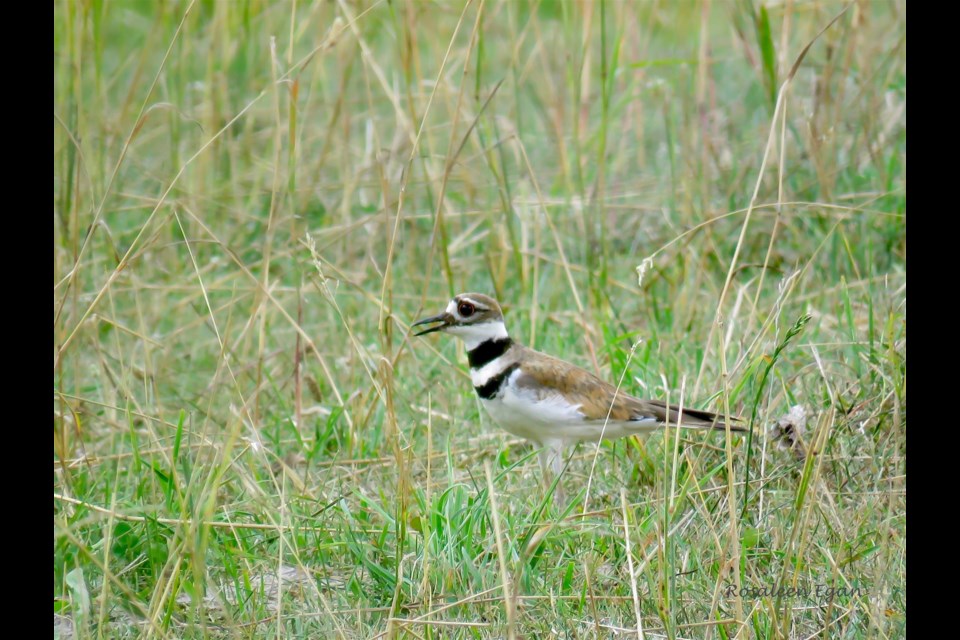It was an annoying sound that interrupted a lazy summer afternoon. I could tell it was a bird, but I couldn’t tell where it was exactly.
After about 15 minutes of hearing the call from my house, I headed in the general direction from whence the sound came, and scoured the trees. I also looked at the fencing around the cow pasture because that’s where it seemed to be coming from.
The cows appeared fairly tolerant of the shrill sound. Here a cow mooed; there a cow mooed. I imagined it was more at me than the irritating sound. It’s hard to tell with cows.
It was a quick movement in the grass that finally caught my attention. A slender bird ran, stopped suddenly and yelled some more. It was a killdeer. I have heard the repetitive call of the killdeer that sounds like its name, but this was an incessant shrill sort of beep.
Killdeer is a type of plover, and considered a shorebird. They can even swim. Just the same, they also thrive in fields and other places far from water. Their nests are small depressions scratched in the ground where there is short grass or rocks. Killdeer sometimes come back from wintering grounds individually and then pair up. Generally, they flock together in late summer as they prepare to go south.
Although mid-summer, this noisy one seemed to be on its own. I don’t know what it was going on about. I understand they sometimes object when cows are too close to a nesting site, so it may have been that. It may also have been calling for a mate. The noise began far before I got there, so it wasn’t me.
Allaboutbirds.org says, “Eighteenth-century naturalists also noticed how noisy killdeer are, giving them names such as the chattering plover and the noisy plover.” I feel validated.
According to Hinterland Who’s Who (HWW), “An adult bird will run with outstretched wings or fly directly toward any browsing animal that appears on the verge of walking into a nest or stepping on a chick. There are recorded instances of a cow being struck on the muzzle.” I sort of wish I’d seen that.
I watched the bird for some time to determine what all the fuss was about, but at one point it flew away, leaving no clues. I went back when the cows were farther out in the pasture, hoping I might see a nest. Each visit, I stayed outside the fence.
For one thing, I didn’t want to mistakenly step on a nest, and the other thing is there is a bull in with the cows. He seems to have a gentle demeanour. Still, it’s hard to tell with bulls.
The first time I saw a killdeer here, it was walking up and down the laneway before the snow had melted one spring. I could easily see its slender form, colouration, and long legs. I watched it pull worms out of gravel. Besides worms, they eat such delicacies as centipedes, crayfish, snails, grasshoppers, beetles and insects. Some of those things can be harmful to crops, so killdeer help farmers.
I have seen killdeer in the open fields, and once I witnessed the famous move of pretending to be injured to distract predators from a nest.
I like this description from hww.ca: “The bird crouches on the ground with one wing spread and hanging as though broken. It flops about in a piteous manner, at the same time crying kill-dee-dee-ee as though in mortal pain.”
The predator goes after the “injured” bird that makes a miraculous recovery when the nest is out of danger. It’s hard to tell with killdeer.
I share experiences of bird visitors to this property with readers every couple of weeks. Until next time, keep your eye to the sky, and look for birds that may come by.
To hear killdeer sounds, go to allaboutbirds.org/guide/killdeer/sounds.
Rosaleen Egan is a freelance journalist, a storyteller, and a playwright. She blogs on her website, rosiewrites.com.
